2014 MERCEDES-BENZ GL tow
[x] Cancel search: towPage 271 of 462
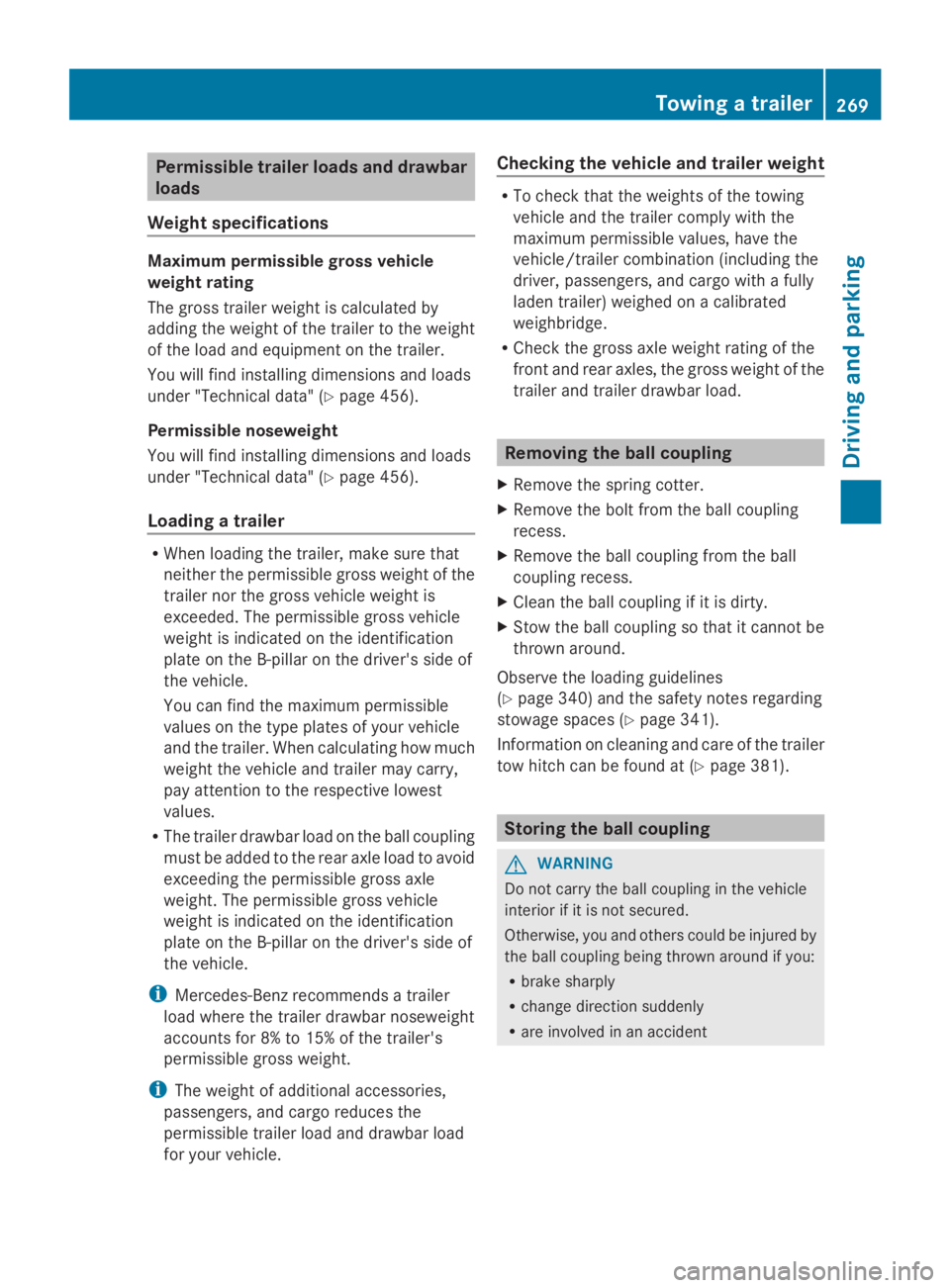
Permissible trailer loads and drawbar
loads
Weight specifications
Maximum permissible gross vehicle
weight rating
The gross trailer weight is calculated by
adding the weight of the trailer to the weight
of the load and equipment on the trailer.
You will find installing dimensions and loads
under "Technical data" (Ypage 456).
Permissible noseweight
You will find installing dimensions and loads
under "Technical data" (Ypage 456).
Loading a trailer
RWhen loading the trailer, make sure that
neither the permissible gross weight of the
trailer nor the gross vehicle weight is
exceeded. The permissible gross vehicle
weight is indicated on the identification
plate on the B-pillar on the driver's side of
the vehicle.
You can find the maximum permissible
values on the type plates of your vehicle
and the trailer. When calculating how much
weight the vehicle and trailer may carry,
pay attention to the respective lowest
values.
RThe trailer drawbar load on the ball coupling
must be added to the rear axle load to avoid
exceeding the permissible gross axle
weight. The permissible gross vehicle
weight is indicated on the identification
plate on the B-pillar on the driver's side of
the vehicle.
iMercedes-Benz recommends a trailer
load where the trailer drawbar noseweight
accounts for 8% to 15% of the trailer's
permissible gross weight.
iThe weight of additional accessories,
passengers, and cargo reduces the
permissible trailer load and drawbar load
for your vehicle.
Checking the vehicle and trailer weight
RTo check that the weights of the towing
vehicle and the trailer comply with the
maximum permissible values, have the
vehicle/trailer combination (including the
driver, passengers, and cargo with a fully
laden trailer) weighed on a calibrated
weighbridge.
RCheck the gross axle weight rating of the
front and rear axles, the gross weight of the
trailer and trailer drawbar load.
Removing the ball coupling
XRemove the spring cotter.
XRemove the bolt from the ball coupling
recess.
XRemove the ball coupling from the ball
coupling recess.
XClean the ball coupling if it is dirty.
XStow the ball coupling so that it cannot be
thrown around.
Observe the loading guidelines
(Ypage 340) and the safety notes regarding
stowage spaces (Ypage 341).
Information on cleaning and care of the trailer
tow hitch can be found at (Ypage 381).
Storing the ball coupling
GWARNING
Do not carry the ball coupling in the vehicle
interior if it is not secured.
Otherwise, you and others could be injured by
the ball coupling being thrown around if you:
Rbrake sharply
Rchange direction suddenly
Rare involved in an accident
Towing a trailer269
Driving and parking
Z
Page 272 of 462
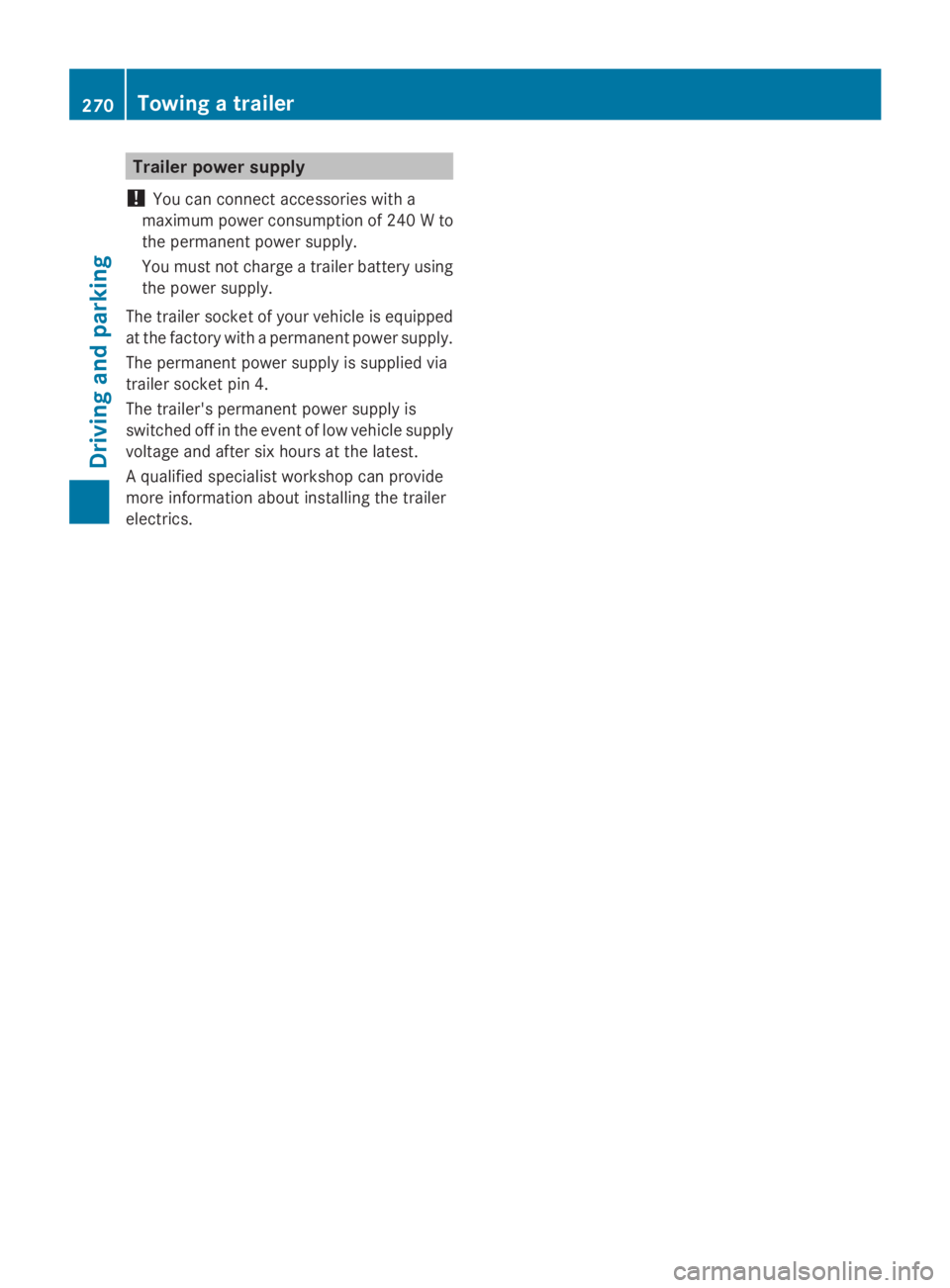
Trailer power supply
!You can connect accessories with a
maximum power consumption of 240Wto
the permanent power supply.
You must not charge a trailer battery using
the power supply.
The trailer socket of your vehicle is equipped
at the factory with a permanent power supply.
The permanent power supply is supplied via
trailer socket pin 4.
The trailer's permanent power supply is
switched off in the event of low vehicle supply
voltage and after six hours at the latest.
A qualified specialist workshop can provide
more information about installing the trailer
electrics.
270Towing a trailer
Driving an d parking
Page 297 of 462
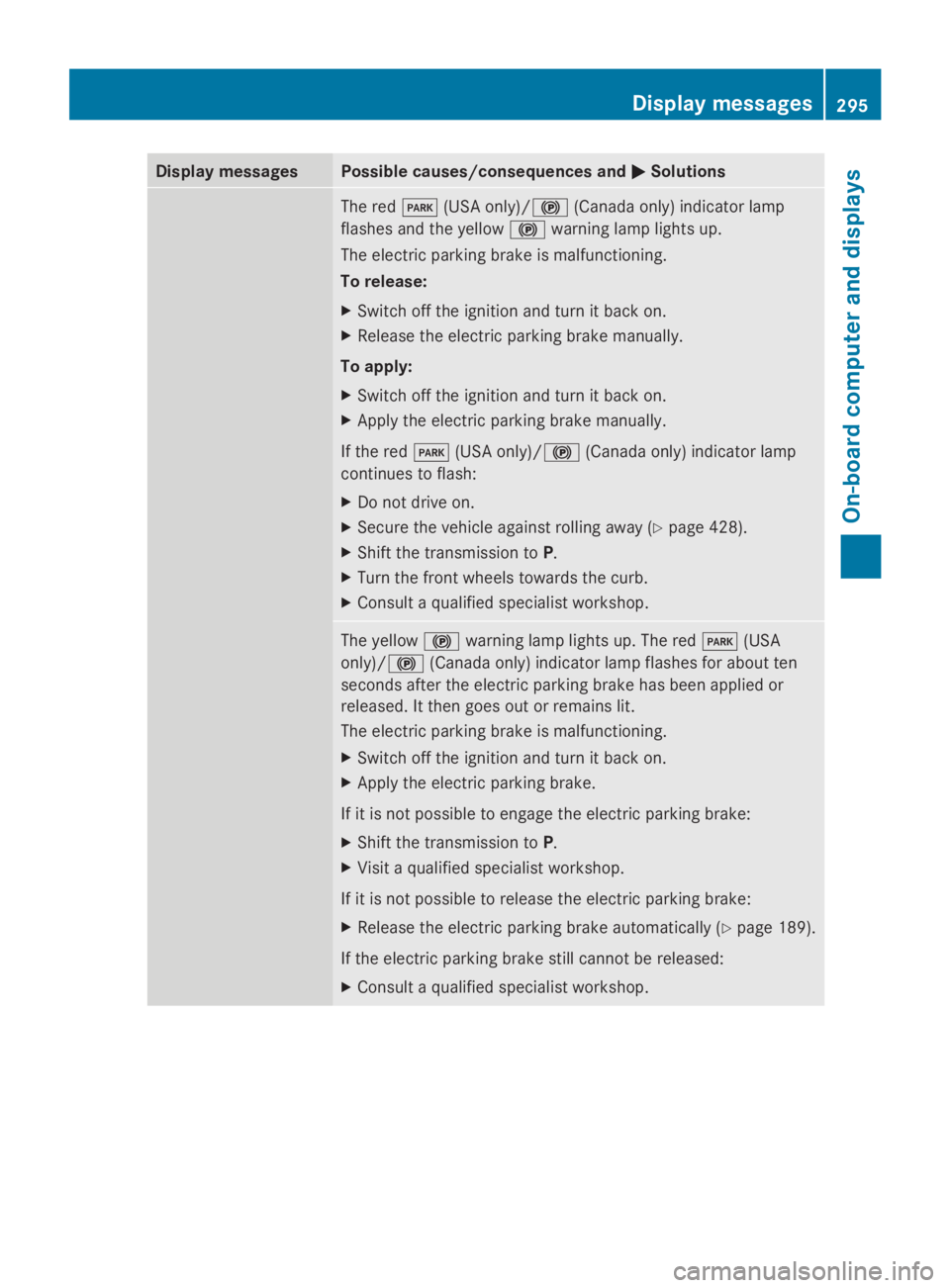
Display messagesPossible causes/consequences and�P�PSolutions
The red�I(USA only)/�$(Canada only) indicator lamp
flashes and the yellow�$warning lamp lights up.
The electric parking brake is malfunctioning.
To release:
XSwitch off the ignition and turn it back on.
XRelease the electric parking brake manually.
To apply:
XSwitch off the ignition and turn it back on.
XApply the electric parking brake manually.
If the red�I(USA only)/�$(Canada only) indicator lamp
continues to flash:
XDo not drive on.
XSecure the vehicle against rolling away (Ypage 428).
XShift the transmission toP.
XTurn the front wheels towards the curb.
XConsult a qualified specialist workshop.
The yellow�$warning lamp lights up. The red�I(USA
only)/�$(Canada only) indicator lamp flashes for about ten
seconds after the electric parking brake has been applied or
released. It then goes out or remains lit.
The electric parking brake is malfunctioning.
XSwitch off the ignition and turn it back on.
XApply the electric parking brake.
If it is not possible to engage the electric parking brake:
XShift the transmission toP.
XVisit a qualified specialist workshop.
If it is not possible to release the electric parking brake:
XRelease the electric parking brake automatically (Ypage 189).
If the electric parking brake still cannot be released:
XConsult a qualified specialist workshop.
Displaymessages295
On-b oard computer and displays
Z
Page 307 of 462
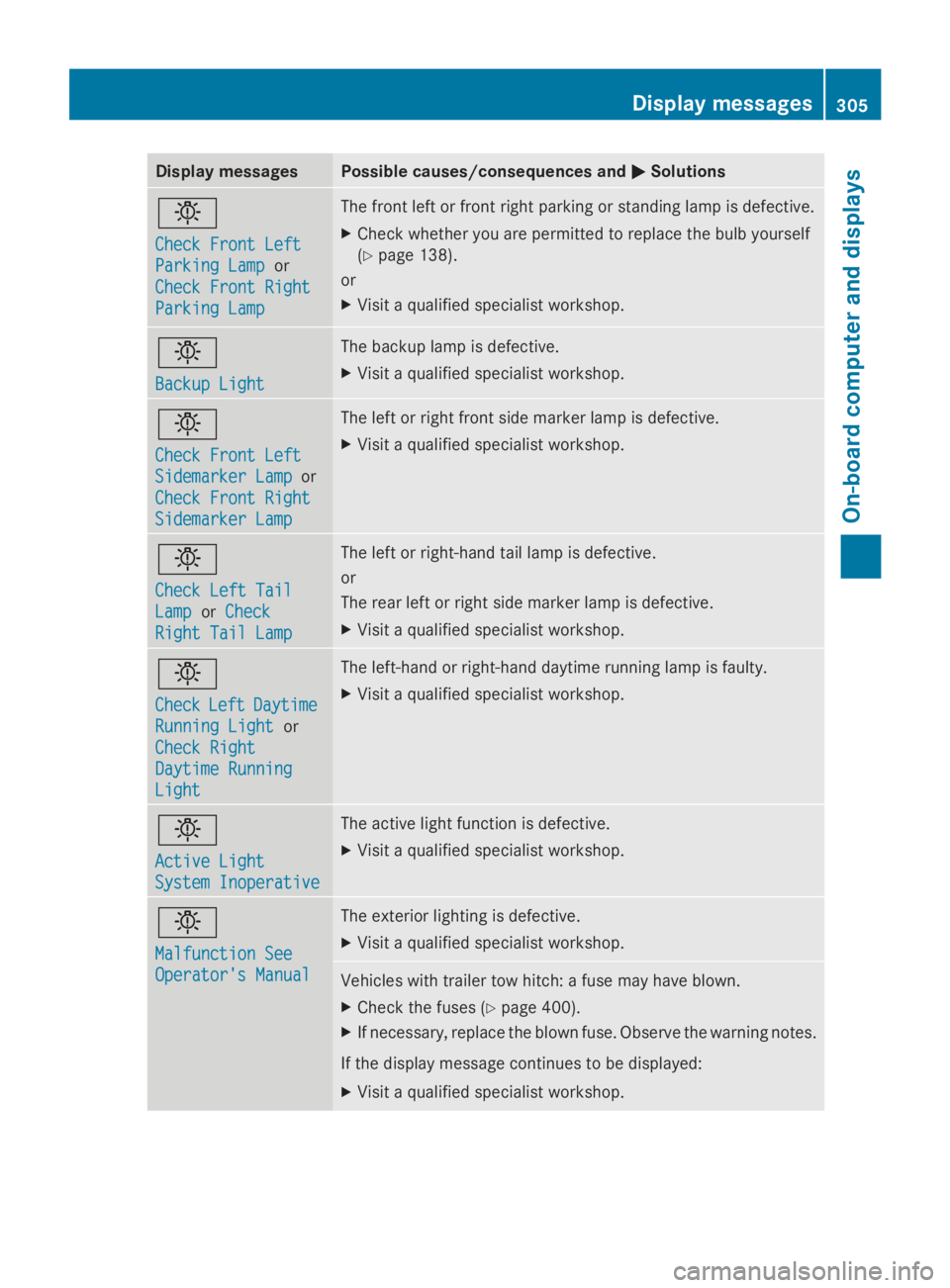
Display messagesPossible causes/consequences and�P�PSolutions
�I
Check Front LeftCheck Front Left
Parking LampParking Lampor
Check Front RightCheck Front Right
Parking LampParking Lamp
The front left or front right parking or standing lamp is defective.
XCheck whether you are permitted to replace the bulb yourself
(Ypage 138).
or
XVisit a qualified specialist workshop.
�I
Backup LightBackup Light
The backup lamp is defective.
XVisit a qualified specialist workshop.
�I
Check Front LeftCheck Front Left
Sidemarker LampSidemarker Lampor
Check Front RightCheck Front Right
Sidemarker LampSidemarker Lamp
The left or right front side marker lamp is defective.
XVisit a qualified specialist workshop.
�I
Check Left TailCheck Left Tail
LampLamporCheckCheck
Right Tail LampRight Tail Lamp
The left or right-hand tail lamp is defective.
or
The rear left or right side marker lamp is defective.
XVisit a qualified specialist workshop.
�I
CheckCheckLeftLeftDaytimeDaytime
Running LightRunning Lightor
Check RightCheck Right
Daytime RunningDaytime Running
LightLight
The left-hand or right-hand daytime running lamp is faulty.
XVisit a qualified specialist workshop.
�I
Active LightActive Light
System InoperativeSystem Inoperative
The active light function is defective.
XVisit a qualified specialist workshop.
�I
Malfunction SeeMalfunction See
Operator's ManualOperator's Manual
The exterior lighting is defective.
XVisit a qualified specialist workshop.
Vehicles with trailer tow hitch: a fuse may have blown.
XCheck the fuses (Ypage 400).
XIf necessary, replace the blown fuse. Observe the warning notes.
If the display message continues to be displayed:
XVisit a qualified specialist workshop.
Displaymessages305
On-b oard computer and displays
Z
Page 316 of 462

Display messagesPossible causes/consequences and�P�PSolutions
Blind Spot AssistBlind Spot Assist
CurrentlyCurrently
Unavailable SeeUnavailable See
Operator's ManualOperator's Manual
orActive BlindActive Blind
Spot AssistSpot Assist
CurrentlyCurrently
Unavailable SeeUnavailable See
Operator's ManualOperator's Manual
Blind Spot Assist or Active Blind Spot Assist is temporarily
inoperative. Possible causes are:
Rthe sensors are dirty.
Rfunction is impaired due to heavy rain or snow.
Rthe radar sensor system is outside the operating temperature
range.
Rthe radar sensor system is temporarily inoperative, e.g. due to
electromagnetic radiation emitted by nearby TV or radio
stations or other sources of electromagnetic radiation.
The yellow�cindicator lamps also light up in the exterior
mirrors.
When the causes stated above no longer apply, the display
message disappears.
Blind Spot Assist or Active Blind Spot Assist is operational again.
If the display message does not disappear:
XPull over and stop the vehicle safely as soon as possible, paying
attention to road and traffic conditions.
XSecure the vehicle against rolling away (Ypage 188).
XClean the sensors (Ypage 380).
XRestart the engine.
Blind Spot Assist or Active Blind Spot Assist is deactivated while
towing a trailer.
You have established the electrical connection between the trailer
and your vehicle.
XPress�von the steering wheel to confirm the display
message.
Blind Spot AssistBlind Spot Assist
InoperativeInoperativeor
Active Blind SpotActive Blind Spot
Assist InoperativeAssist Inoperative
Blind Spot Assist or Active Blind Spot Assist is defective.
The yellow�cindicator lamps also light up in the exterior
mirrors.
XVisit a qualified specialist workshop.
Park AssistPark Assist
CanceledCanceled
The driver's door is open and the driver's seat belt has not been
fastened.
XRepeat the parking process with the seat belt fastened and the
driver's door closed.
You have inadvertently touched the multifunction steering wheel
while steering intervention was active.
XWhile steering intervention is active, make sure that the
multifunction steering wheel is not touched unintentionally.
314Displaymessages
On-b oard computer and displays
Page 341 of 462
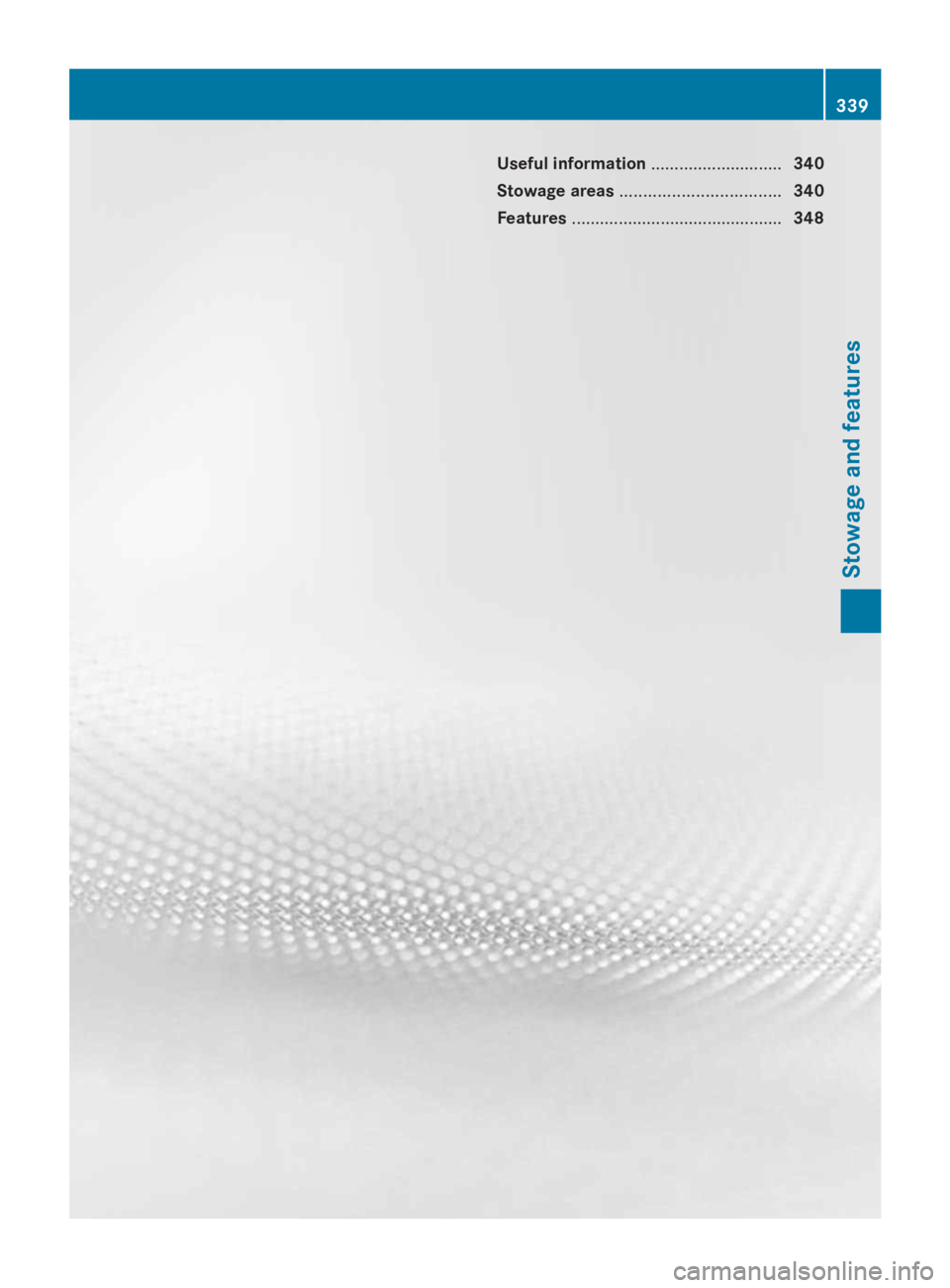
Useful information............................340
Stowage areas..................................340
Features.............................................348
339
Stowage and features
Page 342 of 462

Useful information
iThis Operator's Manual describes all
models and all standard and optional
equipment of your vehicle available at the
time of publication of the Operator's
Manual. Country-specific differences are
possible. Please note that your vehicle may
not be equipped with all features
described. This also applies to safety-
related systems and functions.
iRead the information on qualified
specialist workshops: (Ypage 28).
Stowage areas
Loading guidelines
GWARNING
If objects, luggage or loads are not secured or
not secured sufficiently, they could slip, tip
over or be flung around and thereby hit vehicle
occupants. There is a risk of injury,
particularly in the event of sudden braking or
a sudden change in direction.
Always store objects so that they cannot be
flung around. Secure objects, luggage or
loads against slipping or tipping before the
journey.
GWARNING
Combustion engines emit poisonous exhaust
gases such as carbon monoxide. If the tailgate
is open when the engine is running,
particularly if the vehicle is moving, exhaust
fumes could enter the passenger
compartment. There is a risk of poisoning.
Turn off the engine before opening the
tailgate. Never drive with the tailgate open.
The gross vehicle weight (GVW) is the vehicle
weight including fuel, vehicle tool kit, spare
wheel, installed accessories, vehicle
occupants and luggage/cargo.
The gross load limit and the gross vehicle
weight rating (GVWR) for your vehicle must
never be exceeded. The gross load limit and
the GVWR are specified on the vehicle
identification plate on the B-pillar of the
driver's door (Ypage 415).
The load must also be distributed so that the
weight on each axle never exceeds the gross
axle weight rating (GAWR) for the front and
rear axles. The specifications for GVWR and
GAWR are on the vehicle identification plate
on the B-pillar of the driver's door
(Ypage 415).
Observe the notes on the loading the vehicle
(Ypage 415).
The handling characteristics of a laden
vehicle are dependent on the distribution of
the load within the vehicle. For this reason,
you should observe the following notes when
transporting a load:
RNever exceed the maximum permissible
gross vehicle weight or the gross axle
weight rating of the vehicle (including
occupants).
RThe cargo compartment is the preferred
place to carry objects.
RPosition heavy loads as far forwards as
possible and as low down in the cargo
compartment as possible.
RThe load must not protrude above the
upper edge of the seat backrests.
RAlways place the load against the rear or
front seat backrests. Make sure that the
seat backrests are securely locked into
place.
RAlways place the load behind unoccupied
seats if possible.
RUse the cargo tie down rings and the parcel
nets to transport loads and luggage.
RUse cargo tie-down rings and fastening
materials appropriate for the weight and
size of the load.
RHook in the cargo net when loading.
RSecure the load with sufficiently strong and
wear-resistant tie-downs. Pad sharp edges
for protection.
340Stowage areas
Stowage and features
Page 343 of 462

Stowage space
Important safety notes
GWARNING
If objects in the passenger compartment are
stowed incorrectly, they can slide or be
thrown around and hit vehicle occupants.
There is a risk of injury, particularly in the
event of sudden braking or a sudden change
in direction.
RAlways stow objects so that they cannot be
thrown around in such situations.
RAlways make sure that objects do not
protrude from stowage spaces, parcel nets
or stowage nets.
RClose the lockable stowage spaces while
driving.
RStow and secure objects that are heavy,
hard, pointy, sharp-edged, fragile or too
large in the cargo compartment.
Observe the loading guidelines (Ypage 340).
Glove box
XTo open:pull handle�Cand open glove box
flap�D.
XTo close:fold glove box flap�Dupwards
until it engages.
iThe glove box can be cooled and
ventilated (Ypage 163).
�GGlove box unlocked
�HGlove box locked
The glove box can be locked and unlocked
using the mechanical key.
Partition�Cfor stowing flat objects is located
in the upper section of the glove box. It can
be removed to increase the stowage space in
the glove box.
XTo remove:pull partition�Cforwards and
out
XTo install:insert partition�Cand push it
back until it engages.
Stowage areas341
Stowage and features
Z